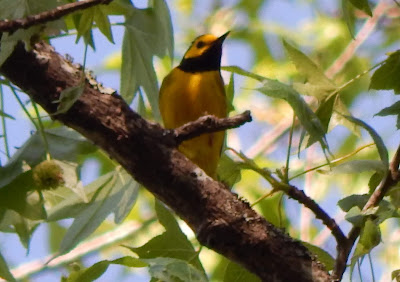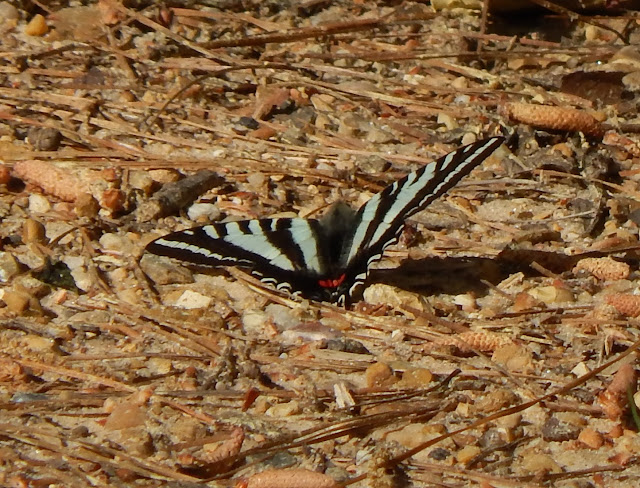 |
| woods of National Catahoula Wildlife Management Preserve - 3/28/19 |
 |
| some habitat shots of National Catahoula Wildlife Management Preserve |
 |
| ... |
 |
| ... |
 |
| Iatt Creek |
 |
| controlled burn near US-167 |
 |
| ... |
 |
| ... |
 |
| ... |
 |
| ... |
This is Pine Warbler paradise, and on this morning the woods were ringing with their song. Hooded Warblers had arrived, though they won't be in peak numbers for a while -- by mid-April they can rival the Pine Warblers.
 |
| male Hooded Warbler - 3/28 - same bird singing in video below |
Many of the preserve's streams are home to Louisiana Waterthrushes during the breeding season, and on this morning we heard one singing at one location and one calling at another. Northern Parulas are common in the larger creek bottom woods. Many of the other spring and summer breeders haven't arrived yet, but as the season progresses this location becomes especially good for finding Chuck-will's-widow and Broad-winged Hawk, as well as many of the neotropical songbirds.
(video of birdsong: Hooded Warbler, Tufted Titmouse, Northern Parula, White-eyed Vireo, Blue Jay)
Of course many winter species are still around. This has been an irruption year for Red-breasted Nuthatch, and we heard two on this morning at separate locations.
Parts of the preserve offer what appears to be good habitat for Bachman's Sparrow, though we weren't in those areas during prime listening time and drove through some such habitat without stopping.
Below is a list of all birds detected that morning from various locations on the preserve. After that is a rundown of some of the other wildlife, and plant life, that we noticed.
Wood Duck - 1
Wild Turkey - 4
Mourning Dove - 2
Killdeer - 1
Red-shouldered Hawk - 2
Barred Owl - 9
Red-bellied Woodpecker - 11
Downy Woodpecker - 4
Pileated Woodpecker - 4
Northern Flicker - 1
White-eyed Vireo - 5
Yellow-throated Vireo - 7
(video of Yellow-throated Vireo singing in treetop)
Blue Jay - 4
American Crow - 13
Carolina Chickadee - 19
Tufted Titmouse - 35 (1x1)
Red-breasted Nuthatch - 2
Carolina Wren - 19
Blue-gray Gnatcatcher - 2
Golden-crowned Kinglet - 1
Ruby-crowned Kinglet - 6
Brown Thrasher - 1
American Goldfinch - 5
White-throated Sparrow - 2
Louisiana Waterthrush - 2
Black-and-white Warbler - 1
Hooded Warbler - 15 (1x1)
 |
| male Hooded Warbler |
Pine Warbler - 50 (1x1)
Yellow-rumped Warbler - 5 (1x1)
Northern Cardinal - 20 (1x1)
 |
| This juvenile Timber Rattlesnake looks to have been dead for a couple of days. |
Temperatures were cool in the morning and we left about the time butterfly activity would have been picking up, but we still noticed a few. The highlight was a gorgeous Zebra Swallowtail.
 |
| Zebra Swallowtail |
Wild Azaleas (aka "Pink Honeysuckle" - Rhododendron canescens) were in bloom along some of the streams. Red Buckeye (Aesculus pavia) were blooming, as well as violet spp. (Viola). There were A LOT of Flowering Dogwood (Cornus florida) in bloom, making white splashes all in among the pine trunks.
 |
| Flowering Dogwood |
 |
| Snowbell |
 |
| Snowbell |
 |
| Snowbell |
 |
| one of the larger Snowbell (Styrax) trees seen that morning |
 |
| numerous Bluestar (Amsonia) |
 |
| Bluestar (Amsonia) |
 |
| Bluestar (Amsonia) |
 |
| Bluestar (Amsonia) |
 |
| Bluestar (Amsonia) |
 |
| Bluestar (Amsonia) |
I intend to make more trips to National Catahoula Wildlife Management Preserve this year, especially during the spring and early summer. It really is a shame that I let so many years pass without returning to these woods, which are a pretty special place in my estimation. I look forward to reacquainting myself with old familiar locales and exploring some new spots on this large preserve.
As always, if you spot an incorrect i.d. or have suggestions for something that I'm unsure about, feel free to let me know.
 |
| ... |
No comments:
Post a Comment